Nanoemulsions and Solid Microparticles Containing Pentyl Cinnamate to Control Aedes aegypti
Abstract
1. Introduction
2. Results and Discussion
2.1. Esterification Reaction and Product Analysis
2.2. Nanoemulsions Preparation and Analysis
2.3. Larvicidal Activity of Pentyl Cinnamate and Nanoemulsions
2.4. Nanoemulsion Stability
2.5. Spray Drying
2.6. Fourier Transform Infrared Spectroscopy—FTIR
2.7. Scanning Electron Microscopy
2.8. Differential Scanning Calorimetry and Thermogravimetry
3. Materials and Methods
3.1. Esterification of Cinnamic Acid
3.2. Nanoemulsion Preparation and Analysis
3.3. Larvicidal Activity of Pentyl Cinnamate and Nanoemulsions
3.4. Nanoemulsion Stability
3.5. Spray Drying
3.6. Fourier Transform Infrared (FTIR) Spectroscopy
3.7. Scanning Electron Microscopy
3.8. Differential Scanning Calorimetry and Thermogravimetry
4. Conclusions
5. Patents
Supplementary Materials
Author Contributions
Funding
Institutional Review Board Statement
Informed Consent Statement
Data Availability Statement
Acknowledgments
Conflicts of Interest
References
- Prud’homme, S.M.; Chaumot, A.; Cassar, E.; David, J.P.; Reynaud, S. Impact of micropollutants on the life-history traits of the mosquito Aedes aegypti: On the relevance of transgenerational studies. Environ. Pollut. 2017, 220, 242–254. [Google Scholar] [CrossRef] [PubMed]
- Louise, C.; Vidal, P.O.; Suesdek, L. Microevolution of Aedes aegypti. PLoS ONE 2015, 10, e0137851. [Google Scholar] [CrossRef] [PubMed]
- Zanluca, C.; De Melo, V.C.A.; Mosimann, A.L.P.; Dos Santos, G.I.V.; dos Santos, C.N.D.; Luz, K. First report of autochthonous transmission of Zika virus in Brazil. Mem. Inst. Oswaldo Cruz 2015, 110, 569–572. [Google Scholar] [CrossRef] [PubMed]
- Yang, Z.; Statler, B.M.; Calkins, T.L.; Alfaro, E.; Esquivel, C.J.; Rouhier, M.F.; Denton, J.S.; Piermarini, P.M. Dynamic expression of genes encoding subunits of inward rectifier potassium (Kir) channels in the yellow fever mosquito Aedes aegypti. Comp. Biochem. Physiol. Part B Biochem. Mol. Biol. 2017, 204, 35–44. [Google Scholar] [CrossRef]
- Chediak, M.; Pimenta, F.G.; Coelho, G.E.; Braga, I.A.; Lima, J.B.P.; Cavalcante, K.R.L.; de Sousa, L.C.; de Melo-Santos, M.A.V.; Macoris, M.D.L.D.G.; Araújo, A.P.D.; et al. Spatial and temporal country-wide survey of temephos resistance in Brazilian populations of Aedes aegypti. Mem. Inst. Oswaldo Cruz 2016, 111, 311–321. [Google Scholar] [CrossRef]
- Chaudhari, S.P.; Dugar, R.P. Application of surfactants in solid dispersion technology for improving solubility of poorly water soluble drugs. J. Drug Deliv. Sci. Technol. 2017, 41, 68–77. [Google Scholar] [CrossRef]
- Mazzarri, B. Characterization of Resistance to Organophosphate, Carbamate, and Pyrethroid Inseticides in Field Populations of Aedes aegypti from Venezuela. J. Am. Mosq. Control Assoc. 1995, 11, 315–322. [Google Scholar]
- Zara, A.L.; Santos, S.; Oliveira, E.S.; Carvalho, R.G.; Coelho, G.E. Estratégias de controle do Aedes aegypti: Uma revisão. Epidemiol. Serviços Saúde 2016, 25, 391–404. [Google Scholar] [CrossRef]
- Grisolia, C.K. Agrotóxicos, Mutações, Câncer & Reprodução; Editora da Universidade de Brasília: Brasília, Brazil, 2005. [Google Scholar]
- Williams, W.M.; Giddings, J.M.; Purdy, J.; Solomon, K.R.; Giesy, J.P. Ecological Risk Assessment for Chlorpyrifos in Terrestrial and Aquatic Systems in the United States. Rev. Environ. Contam. Toxicol. 2014, 231, 77–117. [Google Scholar] [CrossRef]
- Zeng, H.H.; Lei, C.W.; Zhang, Y.H.; Cao, Y.; Liu, Z.T. Prediction of the joint toxicity of five organophosphorus pesticides to Daphnia magna. Ecotoxicology 2014, 23, 1870–1877. [Google Scholar] [CrossRef]
- Newman, D.J.; Cragg, G.M. Natural Products as Sources of New Drugs from 1981 to 2014. J. Nat. Prod. 2016, 79, 629–661. [Google Scholar] [CrossRef]
- Lim, P.F.C.; Liu, X.Y.; Chan, S. A Review on Terpenes as Skin Penetration Enhancers in Transdermal Drug Delivery. J. Essent. Oil Res. 2009, 21, 423–428. [Google Scholar] [CrossRef]
- Nerio, L.S.; Olivero-Verbel, J.; Stashenko, E. Repellent activity of essential oils: A review. Bioresour. Technol. 2010, 101, 372–378. [Google Scholar] [CrossRef] [PubMed]
- Oliveira, M.O.; Pérez-Castillo, Y.; Oliveira, L.H.G.; Nunes, F.C.; Sousa, D.P. Larvicidal activity of Cinnamic Acid Derivatives: Investigating Alternative Products for Aedes aegypti L. Control. Molecules 2021, 26, 61. [Google Scholar] [CrossRef]
- França, S.B.; Lima, L.C.B.; Cunha, C.R.S.; Anunciação, D.S.; da Silva-Júnior, E.F.; Barros, M.E.D.S.B.; da Paz Lima, D.J. Larvicidal activity and in silico studies of cinnamic acid derivatives against Aedes aegypti (Diptera: Culicidae). Bioorg. Med. Chem. 2021, 44, 116299. [Google Scholar] [CrossRef] [PubMed]
- Fujiwara, G.M.; Annies, V.; De Oliveira, C.F.; Lara, R.A.; Gabriel, M.M.; Betim, F.C.; Nadal, J.M.; Farago, P.V.; Dias, J.F.; Miguel, O.G.; et al. Evaluation of larvicidal activity and ecotoxicity of linalool, methyl cinnamate and methyl cinnamate/linalool in combination against Aedes aegypti. Ecotoxicol. Environ. Saf. 2017, 139, 238–244. [Google Scholar] [CrossRef]
- Leclercq, P.A.; Van Genderen, M.H.P.; Thanh, L.; Van Khiên, P.; Dũng, N.X. Composition of the essential oil from the aerial parts of Piper pierrei C. DC. from Vietnam. J. Essent. Oil Res. 1997, 9, 721–724. [Google Scholar] [CrossRef]
- Belsito, D.; Bickers, D.; Bruze, M. A toxicologic and dermatologic assessment of related esters and alcohols of cinnamic acid and cinnamyl alcohol when used as fragrance ingredients. Food Chem. Toxicol. 2007, 45, S1–S23. [Google Scholar] [CrossRef]
- Bhatia, S.P.; Wellington, G.A.; Cocchiara, J.; Lalko, J.; Letizia, C.S.; Api, A.M. Fragrance material review on pentyl cinnamate. Food Chem. Toxicol. 2007, 45, 29–31. [Google Scholar] [CrossRef]
- Yi, T.; Wan, J.; Xu, H.; Yang, X. A new solid self-microemulsifying formulation prepared by spray-drying to improve the oral bioavailability of poorly water soluble drugs. Eur. J. Pharm. Biopharm. 2008, 70, 439–444. [Google Scholar] [CrossRef]
- Mcclements, D.J.; Decker, E.A.; Park, Y.; Weiss, J. Structural Design Principles for Delivery of Bioactive Components in Nutraceuticals and Functional Foods. Crit. Rev. Food Sci. Nutr. 2009, 49, 577–606. [Google Scholar] [CrossRef] [PubMed]
- Singh, Y.; Meher, J.G.; Raval, K.; Khan, F.A.; Chaurasia, M.; Jain, N.K.; Chourasia, M.K. Nanoemulsion: Concepts, development and applications in drug delivery. J. Control. Release 2017, 252, 28–49. [Google Scholar] [CrossRef] [PubMed]
- Oliveira, A.E.M.F.M.; Bezerra, D.C.; Duarte, J.L.; Cruz, R.A.; Souto, R.N.; Ferreira, R.M.; Nogueira, J.; da Conceicao, E.C.; Leitao, S.; Bizzo, H.R.; et al. Essential oil from Pterodon emarginatus as a promising natural raw material for larvicidal nanoemulsions against a tropical disease vector. Sustain. Chem. Pharm. 2017, 6, 1–9. [Google Scholar] [CrossRef]
- Da Botas, G.S.; Cruz, R.A.S.; De Almeida, F.B.; Duarte, J.L.; Araújo, R.S.; Souto, R.N.P.; Ferreira, R.; Carvalho, J.C.T.; Santos, M.G.; Rocha, L.; et al. Baccharis reticularia DC. and Limonene Nanoemulsions: Promising Larvicidal Agents for Aedes aegypti (Diptera: Culicidae) Control. Molecules 2017, 22, 1990. [Google Scholar] [CrossRef] [PubMed]
- Bazzarelli, F.; Piacentini, E.; Giorno, L. Biophenols-loaded solid lipid particles (SLPs) development by membrane emulsification. J. Membr. Sci. 2017, 541, 587–594. [Google Scholar] [CrossRef]
- Marinopoulou, A.; Karageorgiou, V.; Papastergiadis, E.; Iordanidis, C.; Dagklis, A.; Raphaelides, S.N. Production of spray-dried starch molecular inclusion complexes on an industrial scale. Food Bioprod. Process. 2019, 116, 186–195. [Google Scholar] [CrossRef]
- Galli, G.M.; Roza, L.F.; Santos, R.C.V.; Quatrin, P.M.; Ourique, A.F.; Klein, B.; Wagner, R.; Baldissera, M.D.; Volpato, A.; Campigotto, G.; et al. Low Dose of Nanocapsules Containing Eucalyptus Oil Has Beneficial Repellent Effect against Horn Fly (Diptera: Muscidae). J. Econ. Entomol. 2018, 111, 2983–2987. [Google Scholar] [CrossRef]
- Da Silva, M.R.M.; Ricci-Júnior, E. An approach to natural insect repellent formulations: From basic research to technological development. Acta Trop. 2020, 212, 105419. [Google Scholar] [CrossRef]
- Iranpoor, N.; Firouzabadi, H.; Riazi, A.; Pedrood, K. Regioselective hydrocarbonylation of phenylacetylene to α,β-unsaturated esters and thioesters with Fe(CO)5 and Mo(CO)6. J. Organomet. Chem. 2016, 822, 67–73. [Google Scholar] [CrossRef]
- Páez-Hernández, G.; Mondragón-Cortez, P.; Espinosa-Andrews, H. Developing curcumin nanoemulsions by high-intensity methods: Impact of ultrasonication and microfluidization parameters. LWT 2019, 111, 291–300. [Google Scholar] [CrossRef]
- Banasaz, S.; Morozova, K.; Ferrentino, G.; Scampicchio, M. Encapsulation of Lipid-Soluble Bioactives by Nanoemulsions. Molecules 2020, 25, 3966. [Google Scholar] [CrossRef]
- Rutckeviski, R.; Xavier, F.H., Jr.; Morais, A.R.V.; Amaral-Machado, L.; Do Nascimento Alencar, E.V.E.R.T.O.N.; Genre, J.; De Souza Araujo, A.A.; Tabosa Do Egito, E.S. Therapeutic bullfrog oil-based nanoemulsion for oral application: Development, characterization and stability. Acta Pharm. 2019, 69, 33–48. [Google Scholar] [CrossRef] [PubMed]
- Casadei, M.A.; Cerreto, F.; Cesa, S.; Giannuzzo, M.; Feeney, M.; Marianecci, C.; Paolicelli, P. Solid lipid nanoparticles incorporated in dextran hydrogels: A new drug delivery system for oral formulations. Int. J. Pharm. 2006, 325, 140–146. [Google Scholar] [CrossRef]
- Pinto, N.O.F.; Rodrigues, T.H.S.; Pereira, R.C.A.; e Silva, L.M.A.; Cáceres, C.A.; de Azeredo, H.M.C.; Muniz, C.R.; de Brito, E.S.; Canuto, K.M. Production and physico-chemical characterization of nanocapsules of the essential oil from Lippia sidoides Cham. Ind. Crops Prod. 2016, 86, 279–288. [Google Scholar] [CrossRef]
- Fernandes, D.A.; Barros, R.P.C.; Teles, Y.C.F.; Oliveira, L.H.; Lima, J.B.; Scotti, M.T.; Nunes, F.C.; Conceicao, A.S.; Vanderlei de Souza, M.D.F. Larvicidal compounds extracted from Helicteres velutina K. Schum (Sterculiaceae) evaluated against Aedes aegypti L. Molecules 2019, 24, 2315. [Google Scholar] [CrossRef] [PubMed]
- Pandiyan, G.N.; Mathew, N.; Munusamy, S. Larvicidal activity of selected essential oil in synergized combinations against Aedes aegypti. Ecotoxicol. Environ. Saf. 2019, 174, 549–556. [Google Scholar] [CrossRef] [PubMed]
- Silva, R.L.; Mello, T.R.B.; Sousa, J.P.B.; Albernaz, L.C.; Magalhães, N.M.G.; Morais, L.S.; Francisco, L.R.; Leal, W.S.; Espindola, L.S. Brazilian Cerrado biome essential oils to control the arbovirus vectors Aedes aegypti and Culex quinquefasciatus. Ind. Crops Prod. 2022, 178, 114568. [Google Scholar] [CrossRef]
- Procópio, T.F.; Fernandes, K.M.; Pontual, E.V.; Ximenes, R.M.; de Oliveira, A.R.C.; Souza, C.D.S.; Melo, A.M.M.D.A.; Navarro, D.M.D.A.F.; Paiva, P.M.G.; Martins, G.F.; et al. Schinus terebinthifolius Leaf extract causes midgut damage, interfering with survival and development of Aedes aegypti larvae. PLoS ONE 2015, 10, e0126612. [Google Scholar] [CrossRef]
- Shao, Q.; Yang, B.; Xu, Q.; Li, X.; Lu, Z.; Wang, C.; Huang, Y.; Söderhäll, K.; Ling, E. Hindgut innate immunity and regulation of fecal microbiota through melanization in insects. J. Biol. Chem. 2012, 287, 14270–14279. [Google Scholar] [CrossRef]
- McClement’s, D.J. Food Emulsions Principles, Practices, and Techniques, 3rd ed.; Taylor & Francis: New York, NY, USA, 2016. [Google Scholar] [CrossRef]
- Desai, J.; Thakkar, H. Enhanced oral bioavailability and brain uptake of Darunavir using lipid nanoemulsion formulation. Colloids Surf. B Biointerfaces 2019, 175, 143–149. [Google Scholar] [CrossRef]
- Schuh, R.S.; Bruxel, F.; Teixeira, H.F. Physicochemical properties of lecithin-based nanoemulsions obtained by spontaneous emulsification or high-pressure homogenization. Quim. Nova 2014, 37, 1193–1198. [Google Scholar] [CrossRef]
- Allam, A.N.; Komeil, I.A.; Fouda, M.A.; Abdallah, O.Y. Preparation, characterization an in vivo evaluation of curcumin self-nano phospholipid dispersion as an approach to enhance oral bioavailability. Int. J. Pharm. 2015, 489, 117–123. [Google Scholar] [CrossRef]
- Zhang, L.; Zeng, X.; Fu, N.; Tang, X.; Sun, Y.; Lin, L. Maltodextrin: A consummate carrier for spray-drying of xylooligosaccharides. Food Res. Int. 2018, 106, 383–393. [Google Scholar] [CrossRef]
- El-Sheridy, N.A.; Ramadan, A.A.; Eid, A.A.; El-Khordagui, L.K. Itraconazole lipid nanocapsules gel for dermatological applications: In vitro characteristics and treatment of induced cutaneous candidiasis. Colloids Surf. B Biointerfaces 2019, 181, 623–631. [Google Scholar] [CrossRef] [PubMed]
- Wu, C.; Van de Weert, M.; Baldursdottir, S.G.; Yang, M.; Mu, H. Effect of excipients on encapsulation and release of insulin from spray-dried solid lipid microparticles. Int. J. Pharm. 2018, 550, 439–446. [Google Scholar] [CrossRef] [PubMed]
- Saavedra-Leos, Z.; Leyva-Porras, C.; Araujo-Díaz, S.B.; Toxqui-Terán, A.; Borrás-Enríquez, A.J. Technological Application of Maltodextrins According to the Degree of Polymerization. Molecules 2015, 20, 21067–21081. [Google Scholar] [CrossRef] [PubMed]
- Fernandes, L.P.; Oliveira, W.P.; Sztatisz, J.; Novák, C. Thermal properties and release of Lippia sidoides essential oil from gum arabic/maltodextrin microparticles. J. Therm. Anal. Calorim. 2008, 94, 461–467. [Google Scholar] [CrossRef]
- de Araújo, J.S.F.; de Souza, E.L.; Oliveira, J.R.; Gomes, A.C.A.; Kotzebue, L.R.V.; da Silva Agostini, D.L.; de Oliveira, D.L.V.; Mazzetto, S.E.; da Silva, A.L.; Cavalcanti, M.T. Microencapsulation of sweet orange essential oil (Citrus aurantium var. dulcis) by liophylization using maltodextrin and maltodextrin/gelatin mixtures: Preparation, characterization, antimicrobial and antioxidant activities. Int. J. Biol. Macromol. 2020, 143, 991–999. [Google Scholar] [CrossRef]
- World Health Organization. Guidelines for Laboratory and Field Testing of Mosquito Larvicides; WHO: Geneva, Switzerland, 2005; pp. 1–41. Available online: https://apps.who.int/iris/handle/10665/69101 (accessed on 1 June 2023).
- Silva, R.L.; Demarque, D.P.; Dusi, R.G.; Sousa, J.P.B.; Albernaz, L.C.; Espindola, L.S. Residual Larvicidal Activity of Quinones against Aedes aegypti. Molecules 2020, 25, 3978. [Google Scholar] [CrossRef]
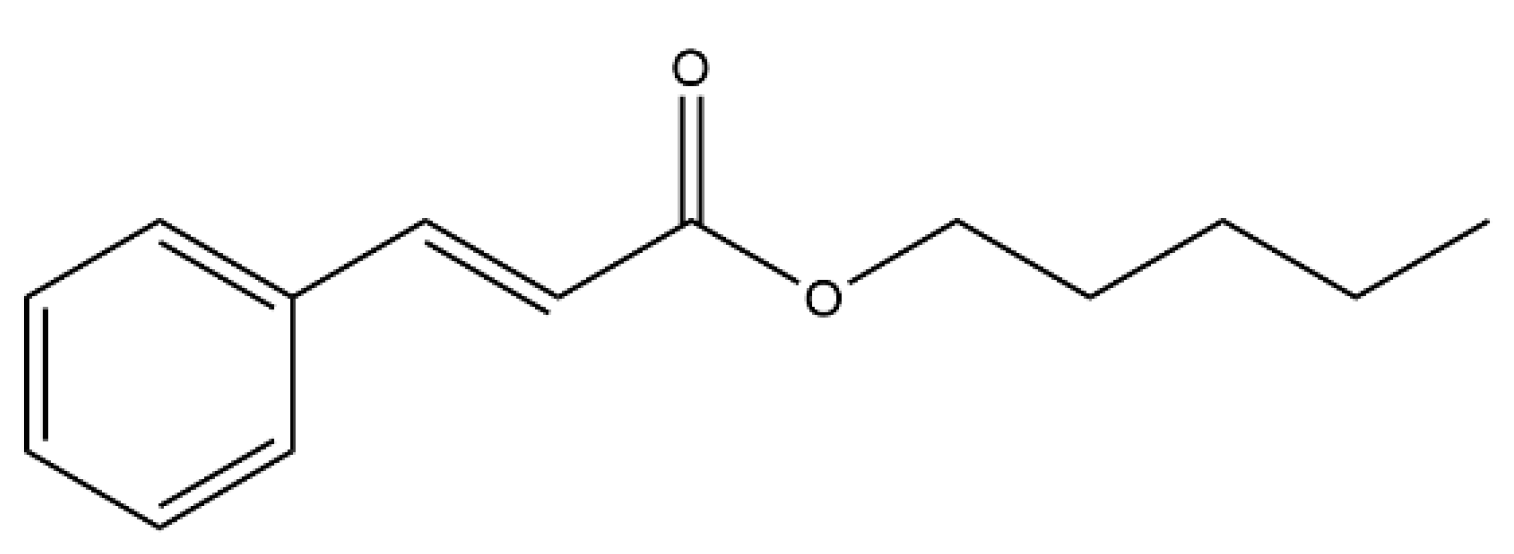
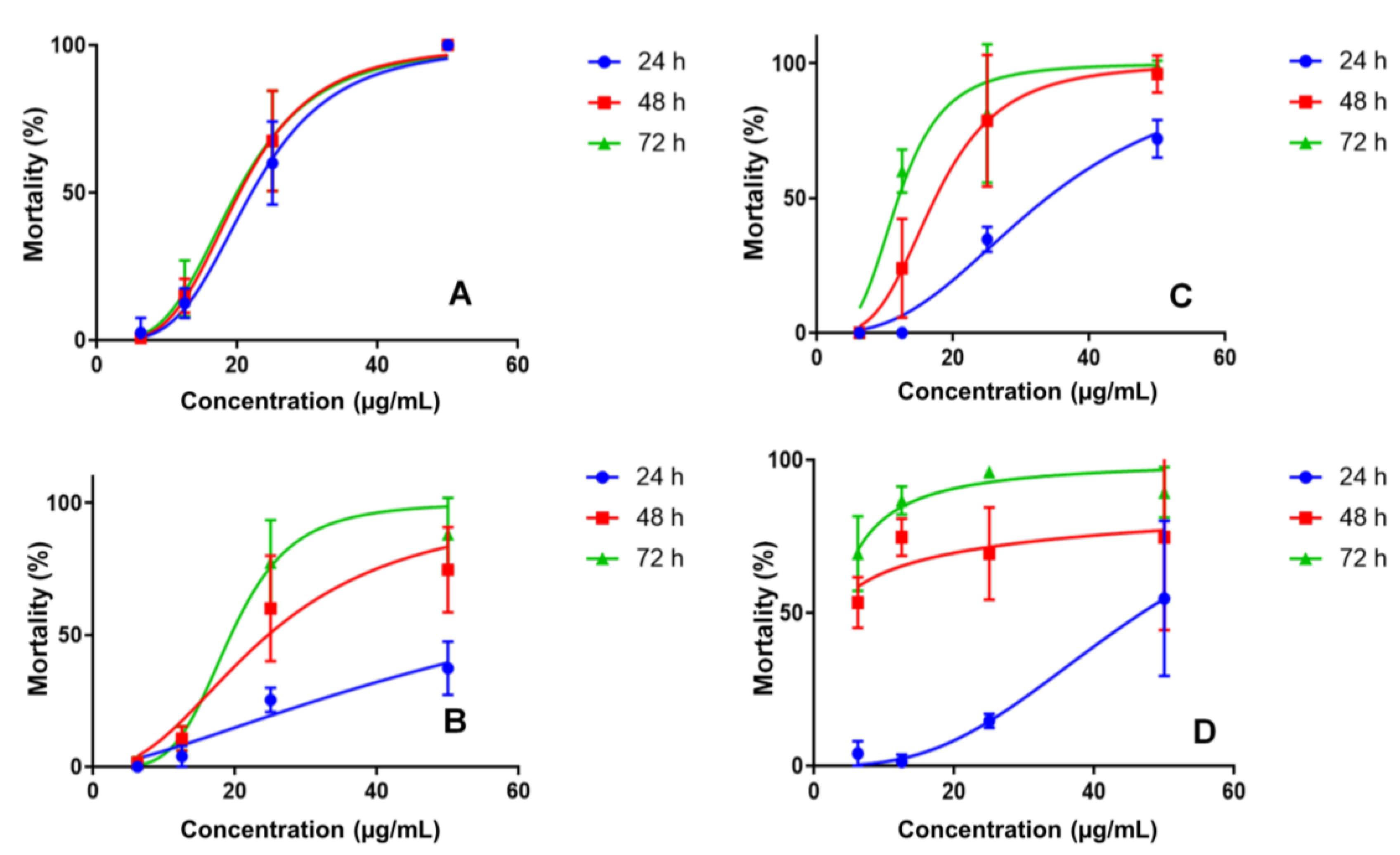
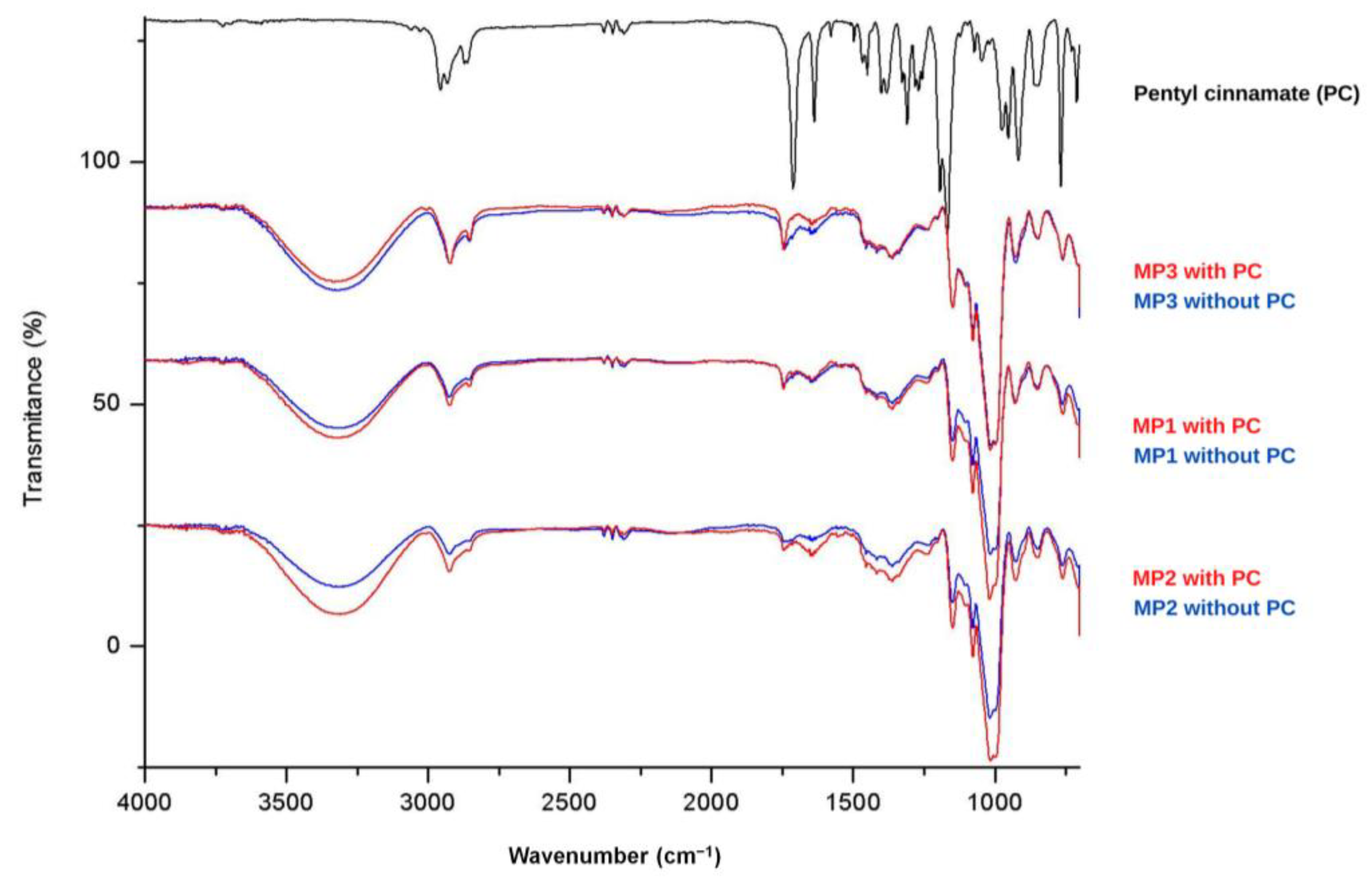
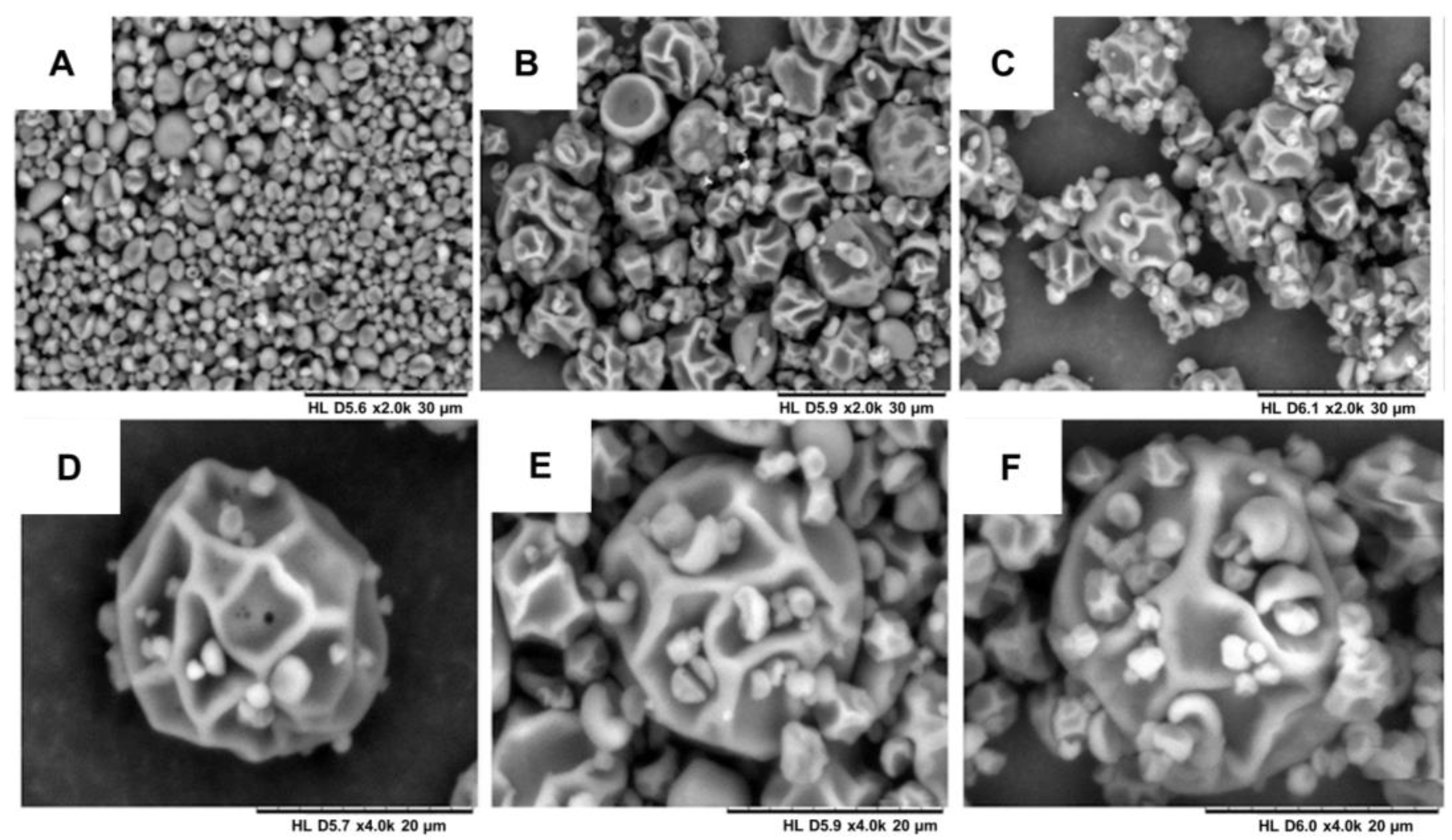
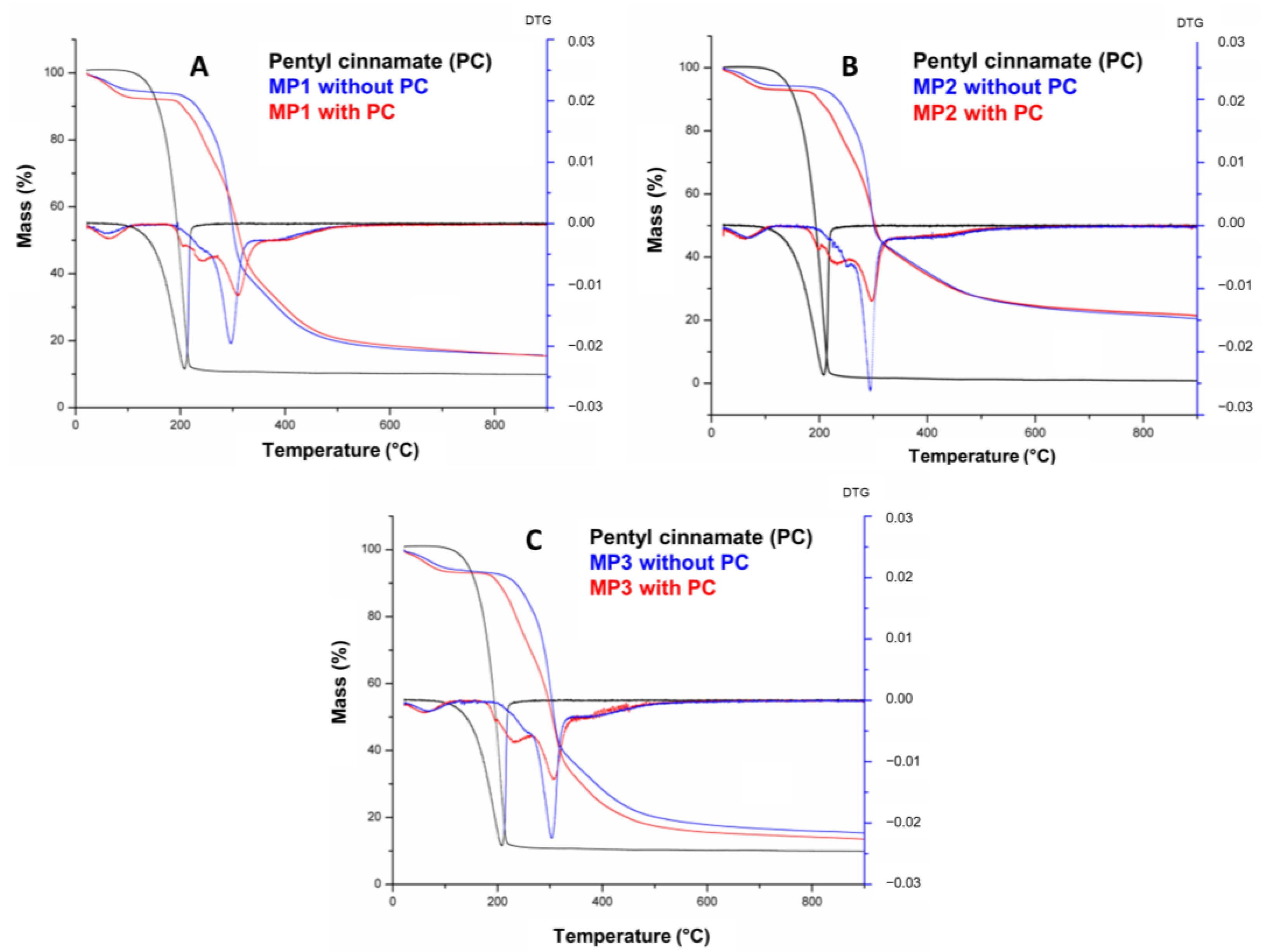
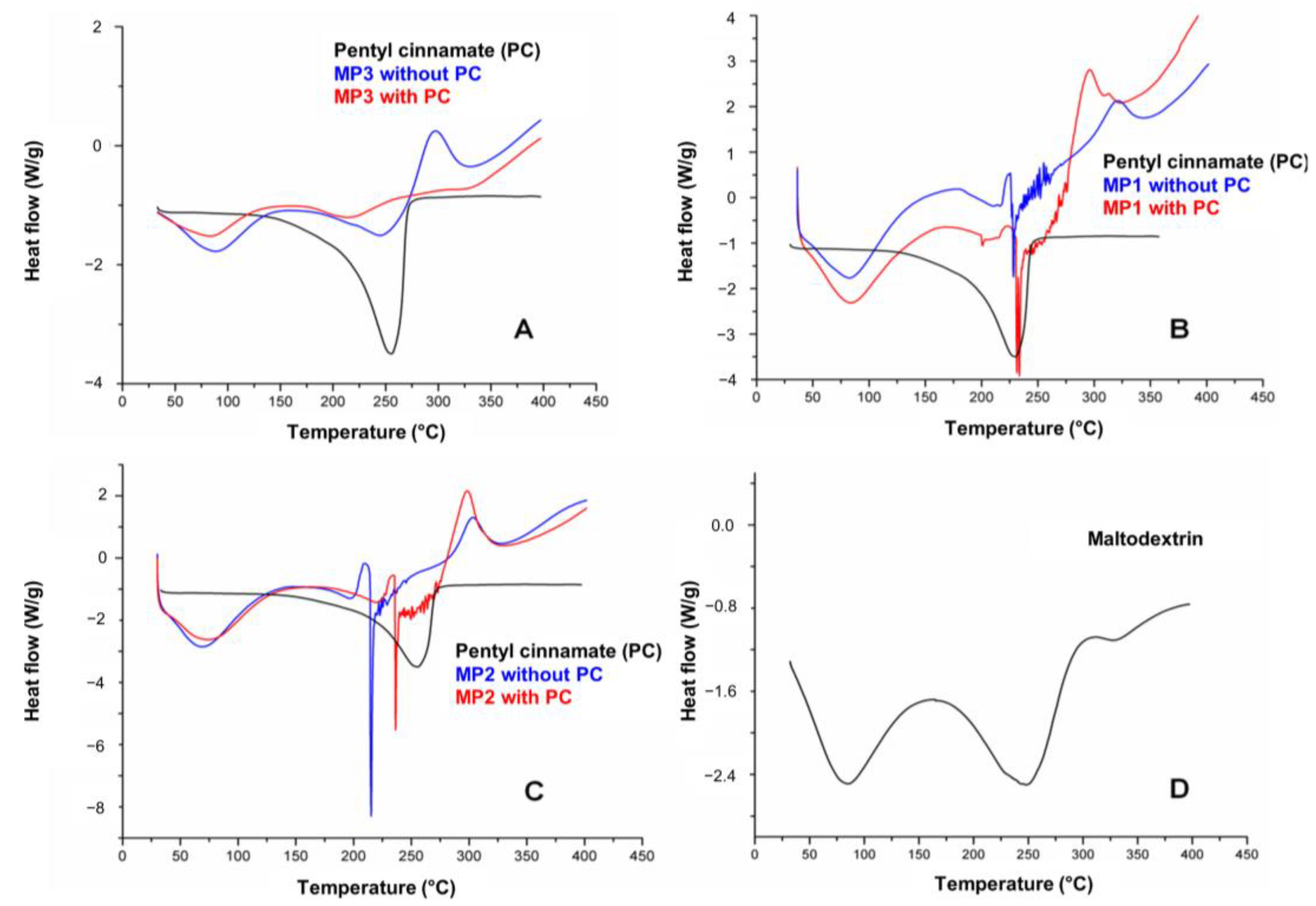
| Sample | T (°C) | Time (Days) | |||||
|---|---|---|---|---|---|---|---|
| Day 0 * | Day 1 * | Day 5 * | Day 15 * | Day 30 * | |||
| NE1 | 4 | Size (nm) PDI | 399 ± 66 0.91 ± 0.15 | 667 ± 132 0.79 ± 0.11 | 724 ± 403 0.81 ± 0.17 | 305 ± 46 0.69 ± 0.14 | 301 ± 37 0.74 ± 0.16 |
| NE1 | 25 | Size (nm) PDI | 399 ± 66 0.91 ± 0.15 | 1481 ± 675 0.86 ± 0.11 | 1.404 ± 555 0.78 ± 0.08 | 610 ± 204 0.78 ± 0.10 | 651 ± 342 0.74 ± 0.09 |
| NE2 | 4 | Size (nm) PDI | 158 ± 3 0.30 ± 0.03 | 160 ± 9 0.30 ± 0.05 | 169 ± 12 0.36 ± 0.08 | 200 ± 47 0.40 ± 0.10 | 207 ± 39 0.39 ± 0.11 |
| NE2 | 25 | Size (nm) PDI | 158 ± 3 0.30 ± 0.03 | 158 ± 3 0.26 ± 0.02 | 233 ± 55 0.34 ± 0.09 | 191 ± 9 0.22 ± 0.06 | 267 ± 10 0.21 ± 0.04 |
| NE3 | 4 | Size (nm) PDI | 460 ± 76 0.61 ± 0.06 | 460 ± 76 0.61 ± 0.06 | 456 ± 81 0.59 ± 0.09 | 578 ± 169 0.68 ± 0.10 | 594 ± 173 0.63 ± 0.12 |
| NE3 | 25 | Size (nm) PDI | 460 ± 76 0.61 ± 0.06 | 556 ± 326 0.64 ± 0.16 | 485 ± 60 0.63 ± 0.13 | 1278 ± 407 0.91 ± 0.11 | 514 ± 332 0.67 ± 0.11 |
| Sample | T (°C) | Time (Days) | |||||
|---|---|---|---|---|---|---|---|
| Day 0 * | Day 1 * | Day 5 * | Day 15 * | Day 30 * | |||
| NE1 | 4 | ZP (mV) | −65 ± 1 | −60 ± 2 | −56 ± 5 | −56 ± 3 | −59 ± 1 |
| NE1 | 25 | −65 ± 1 | −59 ± 4 | −59 ± 1 | −58 ± 3 | −57 ± 3 | |
| NE2 | 4 | ZP (mV) | −28 ± 0 | −29 ± 0 | −34 ± 1 | −29 ± 6 | −32 ± 3 |
| NE2 | 25 | −28 ± 0 | −38 ± 5 | −36 ± 2 | −35 ± 2 | −36 ± 2 | |
| NE3 | 4 | ZP (mV) | −57 ± 1 | −51 ± 2 | −46 ± 4 | −40 ± 1 | −44 ± 2 |
| NE3 | 25 | −57 ± 1 | −45 ± 3 | −47 ± 3 | −42 ± 2 | −47 ± 5 | |
| Sample | 1st Step | 2nd Step | 3rd Step | 4th Step | 5th Step | 6th Step | Total |
|---|---|---|---|---|---|---|---|
| Ti–Tf/°C (∆m%) | Ti–Tf/°C (∆m%) | Ti–Tf/°C (∆m%) | Ti–Tf/°C (∆m%) | Ti–Tf/°C (∆m%) | Ti–Tf/°C (∆m%) | (∆m%) | |
| PC | 97.00–259.39 (97.8) | 97.80 | |||||
| MP1 without PC | 31.94–132.21 (4.91) | 167.46–286.13 (18.80) | 286.13–320.99 (31.22) | 320.99–791.38 (27.84) | 82.77 | ||
| MP1 with PC | 21.82–109.72 (6.86) | 180.59–220.95 (5.80) | 220.95–282.46 (19.38) | 282.46–330.62 (24.99) | 330.62–476.60 (20.14) | 476.60–893.71 (6.15) | 83.32 |
| MP2 without PC | 24.44–113.01 (5.15) | 180.56–270.93 (15.50) | 270.93–309.40 (32.23) | 309.40–474.47(17.74) | 474.47–899.01 (7.96) | 78.58 | |
| MP2 with PC | 29.32–118.48 (5.89) | 180.00–212.99 (4.64) | 212.99–266.49 (16.88) | 266.49–317.31 (25.57) | 317.31–478.24 (16.91) | 478.24–891.94 (6.70) | 76.59 |
| MP3 without PC | 27.22–137.13 (5.53) | 192.09–281.75 (17.17) | 281.75–317.16 (33.18) | 317.16–450.79 (19.65) | 450.79–894.00 (7.53) | 82.86 | |
| MP3 with PC | 26.01–110.50 (5.84) | 177.10–277.68 (27.50) | 277.68–329.08 (28.83) | 329.08–449.77 (16.52) | 449.77–886.05 (6.32) | 85.01 |
Disclaimer/Publisher’s Note: The statements, opinions and data contained in all publications are solely those of the individual author(s) and contributor(s) and not of MDPI and/or the editor(s). MDPI and/or the editor(s) disclaim responsibility for any injury to people or property resulting from any ideas, methods, instructions or products referred to in the content. |
© 2023 by the authors. Licensee MDPI, Basel, Switzerland. This article is an open access article distributed under the terms and conditions of the Creative Commons Attribution (CC BY) license (https://creativecommons.org/licenses/by/4.0/).
Share and Cite
Almeida, A.R.; Morais, W.A.; Oliveira, N.D.; Silva, W.C.G.; Gomes, A.P.B.; Espindola, L.S.; Araujo, M.O.; Araujo, R.M.; Albernaz, L.C.; De Sousa, D.P.; et al. Nanoemulsions and Solid Microparticles Containing Pentyl Cinnamate to Control Aedes aegypti. Int. J. Mol. Sci. 2023, 24, 12141. https://doi.org/10.3390/ijms241512141
Almeida AR, Morais WA, Oliveira ND, Silva WCG, Gomes APB, Espindola LS, Araujo MO, Araujo RM, Albernaz LC, De Sousa DP, et al. Nanoemulsions and Solid Microparticles Containing Pentyl Cinnamate to Control Aedes aegypti. International Journal of Molecular Sciences. 2023; 24(15):12141. https://doi.org/10.3390/ijms241512141
Chicago/Turabian StyleAlmeida, Addison R., Waldenice A. Morais, Nicolas D. Oliveira, Wilken C. G. Silva, Ana P. B. Gomes, Laila S. Espindola, Marianna O. Araujo, Renata M. Araujo, Lorena C. Albernaz, Damião P. De Sousa, and et al. 2023. "Nanoemulsions and Solid Microparticles Containing Pentyl Cinnamate to Control Aedes aegypti" International Journal of Molecular Sciences 24, no. 15: 12141. https://doi.org/10.3390/ijms241512141
APA StyleAlmeida, A. R., Morais, W. A., Oliveira, N. D., Silva, W. C. G., Gomes, A. P. B., Espindola, L. S., Araujo, M. O., Araujo, R. M., Albernaz, L. C., De Sousa, D. P., Aragão, C. F. S., & Ferreira, L. S. (2023). Nanoemulsions and Solid Microparticles Containing Pentyl Cinnamate to Control Aedes aegypti. International Journal of Molecular Sciences, 24(15), 12141. https://doi.org/10.3390/ijms241512141








